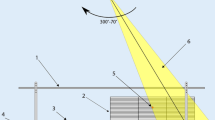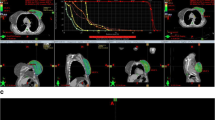Abstract
Purpose
To investigate and to prevent irradiation outside the treatment field caused by an electron stream in the air generated by the magnetic field during magnetic resonance image-guided accelerated partial breast irradiation (APBI).
Materials and methods
In all, 20 patients who received APBI with a magnetic resonance image-guided radiation therapy (MR-IGRT) system were prospectively studied. The prescription dose was 38.5 Gy in 10 fractions of 3.85 Gy and delivered with a tri-cobalt system (the ViewRay system). For each patient, primary plans were delivered for the first five fractions and modified plans with different gantry angles from those of the primary plan (in-treatment plans) were delivered for the remaining five fractions to reduce the skin dose. A 1 cm thick bolus was placed in front of the patient’s jaw, ipsilateral shoulder, and arm to shield them from the electron stream. Radiochromic EBT3 films were attached to the front (towards the breast) and back (towards the head) of the bolus during treatment. Correlations between the measured values and the tumor locations, treatment times, and tumor sizes were investigated.
Results
For a single fraction delivery, the average areas of the measured isodoses of 14% (0.54 Gy), 12% (0.46 Gy), and 10% (0.39 Gy) at the front of the boluses were as large as 3, 10.4, and 21.4 cm2, respectively, whereas no significant dose could be measured at the back of the boluses. Statistically significant but weak correlations were observed between the measured values and the treatment times.
Conclusion
During radiotherapy for breast cancer with an MR-IGRT system, the patient must be shielded from electron streams in the air generated by the interaction of the magnetic field with the beams of the three-cobalt treatment unit to avoid unwanted irradiation of the skin outside the treatment field.
Zusammenfassung
Zielsetzung
Beim Einsatz eines Magnetresonanztomographie(MRT)-geführten Bestrahlungsgeräts kann durch die Wechselwirkung von Magnetfeld und Strahlenquelle unerwünscht ein Elektronenstrahl außerhalb der Therapiefelder entstehen. In dieser Studie wurde für akzelerierte Teilbrustbestrahlungen (APBI) diese Strahlung abgeschirmt und näher untersucht.
Arbeitsmittel und Verfahren
Für diese Studie wurden prospektiv 20 Patientinnen ausgewählt, die eine APBI mit einer MRT-geführten Strahlentherapie (MR-IGRT) erhielten. Die Bestrahlung erfolgte mit einem Tri-Kobalt-System, das mit einem Magnetresonanztomographen kombiniert war (ViewRay). Es wurden jeweils 10 Fraktionen mit einer Einzeldosis von 3,85 Gy und der resultierenden Gesamtdosis von 38,5 Gy appliziert. Zur Reduktion der Hautdosis wurden pro Patientin 2 unterschiedliche Therapiepläne für jeweils 5 Fraktionen mit unterschiedlichen Tragarmwinkeln eingesetzt. Zur Abschirmung des unerwünschten Elektronenstrahls außerhalb der Strahlenfelder wurde ein 1 cm starker Bolus vor dem Kiefer sowie vor der ipsilateralen Schulter und dem Arm der Patientin positioniert. Vor dem Bolusmaterial (Richtung Brust) und hinter dem Bolusmaterial (Richtung Kopf) wurden EBT3-Radiochromröntgenfilme befestigt, um die ein- und austretende Dosis zu messen. Die Abhängigkeiten der Messwerte von der Lokalisation des bestrahlten Tumors, der Bestrahlungszeit und der Tumorgröße wurden untersucht.
Ergebnisse
Für jeweils eine Strahlenfraktion wurden auf den Röntgenfilmen vor dem Bolusmaterial (Richtung Brust) die von den einzelnen Isodosen eingeschlossenen Flächen vermessen: die 14 %-Isodosis (0,54 Gy) umschloss im Mittel eine Fläche von 3,6 cm2, die 12 %-Isodosis (0,46 Gy) im Mittel 10,4 cm2 und die 10 %-Isodosis (0,39 Gy) im Mittel 21,4 cm2. Die Röntgenfilme hinter dem Bolusmaterial zeigten hingegen keine signifikante Dosisbelastung an. Statistisch signifikante, aber nur geringe Korrelationen wurden zwischen der Dosisbelastung und den Behandlungszeiten beobachtet.
Schlussfolgerung
Werden Brustkrebspatientinnen mit einem MRT-geführten Tri-Kobalt-Bestrahlungsgerät behandelt, kann durch eine Wechselwirkung von Strahlenquelle und Magnetresonanztomograph ein Elektronenstrahl außerhalb der Therapiefelder unerwünscht entstehen. Dieser muss zur Schonung der Haut berücksichtigt und abgeschirmt werden.




Similar content being viewed by others
References
Correa C, Harris EE, Leonardi MC et al (2017) Accelerated Partial Breast Irradiation: Executive summary for the update of an ASTRO Evidence-Based Consensus Statement. Pract Radiat Oncol 7:73–79
Smith BD, Arthur DW, Buchholz TA et al (2009) Accelerated partial breast irradiation consensus statement from the American Society for Radiation Oncology (ASTRO). Int J Radiat Oncol Biol Phys 74:987–1001
Polgar C, Van Limbergen E, Potter R et al (2009) Patient selection for accelerated partial-breast irradiation (APBI) after breast-conserving surgery: recommendations of the Groupe Europeen de Curietherapie-European Society for Therapeutic Radiology and Oncology (GEC-ESTRO) breast cancer working group based on clinical evidence. Radiother Oncol 94:264–273
Chang JH, Lee NK, Kim JY et al (2013) Phase II trial of proton beam accelerated partial breast irradiation in breast cancer. Radiother Oncol 108:209–214
Sayan M, Wilson K, Nelson C, Gagne H (2017) Rubin D Heimann R. A novel schedule of accelerated partial breast radiation using intensity-modulated radiation therapy in elderly patients: survival and toxicity analysis of a prospective clinical trial. Radiat Oncol J 35:32–38
Sung K, Lee KC, Lee SH (2014) Ahn SH Choi J. Cardiac dose reduction with breathing adapted radiotherapy using self respiration monitoring system for left-sided breast cancer. Radiat Oncol J 32:84–94
Vicini FA, Chen P, Wallace M et al (2007) Interim cosmetic results and toxicity using 3D conformal external beam radiotherapy to deliver accelerated partial breast irradiation in patients with early-stage breast cancer treated with breast-conserving therapy. Int J Radiat Oncol Biol Phys 69:1124–1130
Rusthoven KE, Carter DL, Howell K et al (2008) Accelerated partial-breast intensity-modulated radiotherapy results in improved dose distribution when compared with three-dimensional treatment-planning techniques. Int J Radiat Oncol Biol Phys 70:296–302
Oliver M, Chen J, Wong E, Van Dyk J, Perera F (2007) A treatment planning study comparing whole breast radiation therapy against conformal, IMRT and tomotherapy for accelerated partial breast irradiation. Radiother Oncol 82:317–323
Park CK, Pritz J, Zhang GG, Forster KM, Harris EE (2012) Validating fiducial markers for image-guided radiation therapy for accelerated partial breast irradiation in early-stage breast cancer. Int J Radiat Oncol Biol Phys 82:e425–e431
Wooten HO, Green O, Yang M et al (2015) Quality of Intensity Modulated Radiation Therapy Treatment Plans Using a (6)(0)Co Magnetic Resonance Image Guidance Radiation Therapy System. Int J Radiat Oncol Biol Phys 92:771–778
Wooten HO, Rodriguez V, Green O et al (2015) Benchmark IMRT evaluation of a Co-60 MRI-guided radiation therapy system. Radiother Oncol 114:402–405
Park JM, Park S, Wu H, Kim J (2015) Commissioning experience of tri-cobalt-60 MRI-guided radiation therapy system. Prog Med Phys 26:193–200
Mutic S, Dempsey JF (2014) The ViewRay system: magnetic resonance-guided and controlled radiotherapy. Semin Radiat Oncol 24:196–199
Kim J, Park S, Lee YH, Shin KH, Wu H, Park JM (2015) Effect of low magnetic field on dose distribution in the partial-breast irradiation. Prog Med Phys 26:208–214
Vicini F, White J, Arthur D, et al (2011) NSABP B‑39/RTOG 0413: A randomized phase III study of conventional whole breast irradiation versus partial breast irradiation for women with stage 0, I, or II breast cancer. Available at: http://www.rtog.org/members/protocols/0413/0413.pdf. Accessed 6 February 2016
Kim JI, Park SY, Kim HJ, Kim JH, Ye SJ, Park JM (2014) The sensitivity of gamma-index method to the positioning errors of high-definition MLC in patient-specific VMAT QA for SBRT. Radiat Oncol 9:167
Reyhan ML, Chen T, Zhang M (2015) Characterization of the effect of MRI on Gafchromic film dosimetry. J Appl Clin Med Phys 16:5743
Micke A, Lewis DF, Yu X (2011) Multichannel film dosimetry with nonuniformity correction. Med Phys 38:2523–2534
Ferreira BC, Lopes MC, Capela M (2009) Evaluation of an Epson flatbed scanner to read Gafchromic EBT films for radiation dosimetry. Phys Med Biol 54:1073–1085
Lewis D, Chan MF (2015) Correcting lateral response artifacts from flatbed scanners for radiochromic film dosimetry. Med Phys 42:416–429
ICRP (2007) The 2007 Recommendations of the International Commission on Radiological Protection. ICRP Publication 103. Ann. ICRP 37(2–4)
Acknowledgements
This work was supported by the National Research Foundation of Korea (NRF) grant funded by the Korea government (MSIP) (No. 2015R1C1A1A01054192).
Author information
Authors and Affiliations
Corresponding author
Ethics declarations
Conflict of interest
J.M. Park, K.H. Shin, J.-i. Kim, S.-Y. Park, S.H. Jeon, N. Choi, J.H. Kim and H.-G. Wu declare that they have no competing interests.
Ethical standards
This study was approved by the institutional review board of Seoul National University College of Medicine/Seoul National University Hospital (IRB No. 1610-083-799).
Rights and permissions
About this article
Cite this article
Park, J.M., Shin, K.H., Kim, Ji. et al. Air–electron stream interactions during magnetic resonance IGRT. Strahlenther Onkol 194, 50–59 (2018). https://doi.org/10.1007/s00066-017-1212-z
Received:
Accepted:
Published:
Issue Date:
DOI: https://doi.org/10.1007/s00066-017-1212-z
Keywords
- Magnetic field
- Magnetic resonance image-guided radiation therapy
- Out-of-field exposure
- Radiation protection
- Organs at risk




